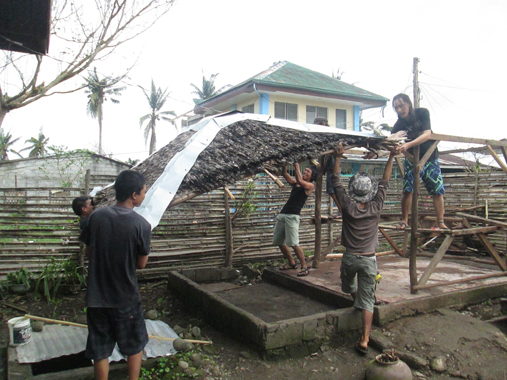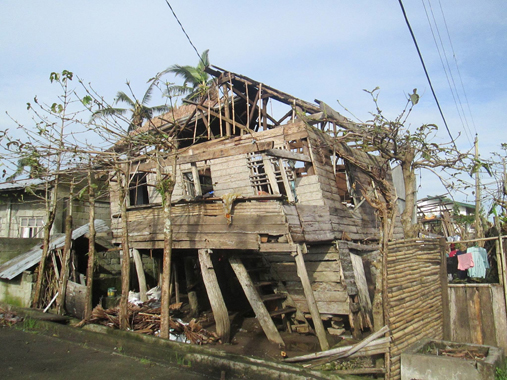| Updated November 26, 2013
PLEASE GIVE TODAY!
Our volunteers are on the front lines again.
Yolanda is one of the most destructive typhoon visited the Philippine
archipelago. It pummeled Visayas region particularly Leyte and some parts
of Cebu and Panay areas. Super typhoon Yolanda left the archipelago with
thousands of dead people, commercial and residential structures are
destroyed, power is knocked-out; agriculture and livelihood are washed-out
that caused billions of losses. Destruction is so extensive that caused
unimaginable effect to the survivors.
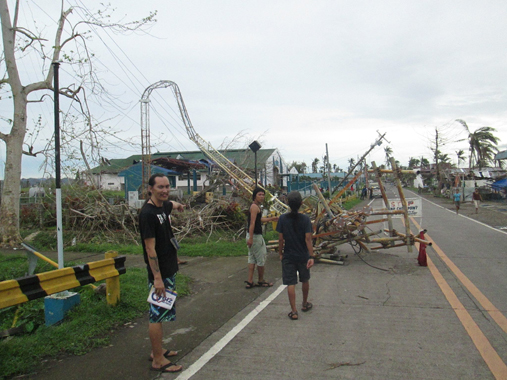 Volunteers helping after Typhoon Yolanda. |
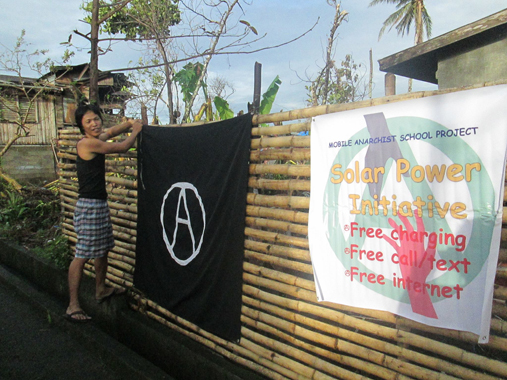 Banners at site of damaged from Typhoon Yolanda. |
Government's Respond caused more devastation to the people
The Philippine archipelago is in the frontline of calamity brought by
storms. It is a common knowledge impossible to miss especially by the
government which is supposed to be the authority in terms of preparation
and rehabilitation. Huge number of dead people scattered in Leyte is
attributable to incapacity of the government to install preparatory
mechanism to lessen casualties, the Philippine government did not learn to
our past experience of havoc due to storm surges.
Reports in relation to looting and violence in Tacloban city and other
municipalities are effects of dirty politics, neglect and corruption. The
inability of the government to provide systematic and effective respond
made people behaved violently; shortage of food is not an issue. The
global attention is on the Philippines for the past few weeks; donations
and support in terms of cash, in kinds and in services are overwhelming.
Ships fully loaded of goods are lined-up in ports of Cebu and Manila;
billions of funds are pouring in through government and corporate accounts
(media); despite of these, victims are scrambling to get food. The feeling
of scarcity and food insecurity forced people to behave violently.
This calamity is one of the most devastating witnessed by global
community, the spirit of solidarity is heartwarming and very effective in
terms of recovery and rehabilitation, but the government’s corrupt
practices undermined this solidarity; two weeks after the horrifying
event, the people in Leyte remained hungry, homeless and seeking medical
support; useless and hazardous materials are everywhere. Prices of basic
commodities increased almost double such as food and medicine; lack of
power supply is a lucrative business that exploits the victims. Local
business offered high rate of charging services to the people for their
emergency lights and mobile phones.
Generally, it is the government's inability to respond swiftly and
appropriately makes the situation much more devastating.
In this context, Mobile Anarchist School decided to act and conducted
direct action; we set an action that could elude government's corrupt
influence. We gathered support from Local Autonomous Network (LAN),
independent collectives and groups and international network.
Power is crucial in terms of rehabilitation and recovery process, so we
focus our effort in consolidating resources to complete a 150 watts solar
set-up to provide free charging services to community to power up
emergency lights, flashlights and mobile phones. After a week of
soliciting support, we procured 160 watts solar panel, 10 ampere solar
control charger, 500 watts inverter and 12 volts/50 ampere starter
battery.
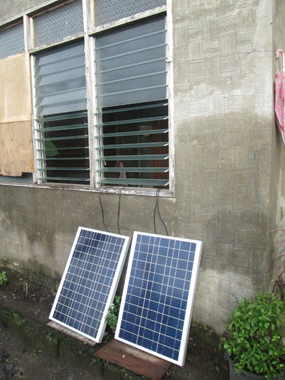 Solar panels after Yolanda. |
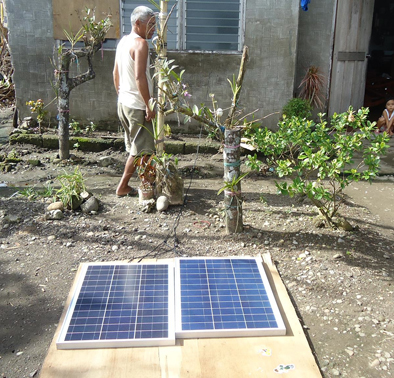 Solar power after Typhoon Yolanda. |
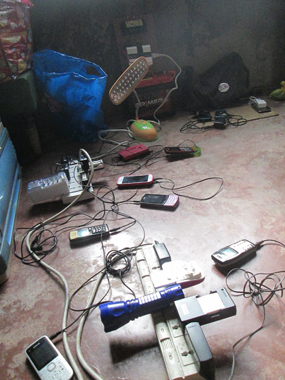 Electric set-up after Yolanda. |
Inter-Island travelling
On the 20th of November we started travelling; our crew with four
volunteers travelled packed with supplies good for a week; we also
prepared packages of relief for 15 families. We made sure that our
equipment is working and in good condition. Bus ride is the most practical
and cheapest way to reach Leyte. We left Cubao Quezon City at 9 AM, we
negotiated the road connecting Manila, Laguna and, Quezon; we took ferry
to cross the sea between Sorsogon and Samar.
As we travel, we witnessed the extensive damage in many municipalities in
Leyte; Yolanda's onslaught starts right after we crossed San Juanico, a
bridge connecting Samar and Leyte. The situation in Tacloban is relatively
peaceful, the people are trying to collect and salvage remaining useful
materials to rebuild their homes at the back draft of heavily devastated
city. We could not find any regular trip so we rented an expensive jeep
going to Municipality of San Miguel. We reached Barangay Libtong, San
Miguel on the 21st of November at four in the afternoon.
Solar Charging Operations
Day 1
Our actual operation started on the 22nd of November, we accommodated at
least 40 units of flashlights and mobile phones and we reserve more units
to be charged on the following day. We conducted informal discussions with
the families and let them talk and share their miseries, grief and
difficulties. Unfortunately, our plan to give a free call and free
internet access for communication purposes did not materialize due to lack
of network signals.
Day 2
Sunlight was poor due to low pressure area that brought rain; we decided
to stop the operation to charge our battery for effective charging
operations. We arranged interviews and discussions with localities and
barangay officials to gather data. More phones and flashlights come in for
charging but we stopped accepting to on the afternoon and asked people to
come back because we can accommodate only very limited units.
Day 3
We resume charging operations; more people are coming in waiting to be
served. Good thing that sun shone entire day and we able to charged at
least 30 units. We reduced number of units to avoid under voltage status.
We observed the process of relief distribution of barangay officials and
Philippines air force.
Day 4
We keep accepting phones and flashlights but we able to charge limited
units. The capacity of our solar set-up could only accommodate 30 units
per day to avoid draining our battery.
Day 5
We conducted an orientation to local volunteers who will maintain our
solar equipment and will facilitate solar charging services. We made sure
that volunteers learn the simple process of operation and maintenance to
continue providing free charging.
We are set to travel going to Ormoc City, from Ormoc took ferry going to
Cebu where we will catch a plane going to Manila. We need to be in Quezon
City in time because we have a climate conference with Evangelical
network.
Ways forward
The incompetence and corruption in the government proved to be more
devastating than the super typhoon itself, we call on the people,
collectives, private sectors and autonomous network to act directly. Avoid
government process because goods and supplies will just end up in storage
facilities accessible only to authorities. There are plenty of reports
with regard to anomalies, we actually witnessed how the authority control
the basic goods for their own purposes. Thousands of socks of rice and
goods are being kept by the authorities and distributing only very limited
supplies to the families who could not access basic commodities.
In our part, we would like to expand our set-up of solar power unit equip
with 300 watts solar panel, 30 ampere solar control charger, 2500 inverter
and two units of 3SM maintenance and deep cycle batteries to accommodate
more units of mobile phones and flashlights. We will organize a Solar
Guerilla Autonomous Response Team that will immediately react in every
calamity and power black-out situation.
In the first week of December we are planning to organize a camp that will
provide relief, medical missions and stress debriefing activities, the
extent of operations will depend on the support and participation from
immediate and extended Network.
Any queries or donation related to this initiative in the Philippine please contact:
aschool@riseup.net
Contact us in the United States to report on your progress and request support by
emailing our office at menu@foodnotbombs.net or calling
us at 1-800-884-1136.
|


